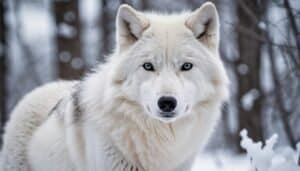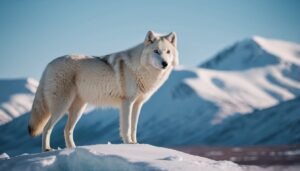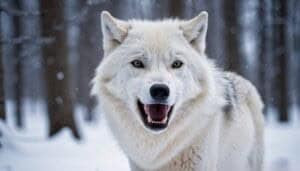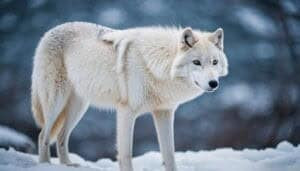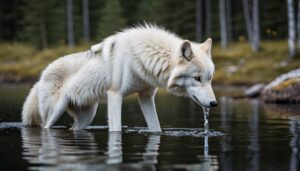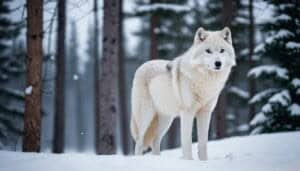Introduction
The resting heart rate of an Arctic wolf is a key indicator of its overall health and well-being. This article explores the average resting heart rate of Arctic wolves, how it compares to other wolves, and the factors influencing it. We will also delve into seasonal changes, the impact of physical activity and stress, and the importance of monitoring this vital sign
Finally, we will discuss the adaptations Arctic wolves have developed to maintain their resting heart rate in extreme cold environments. Let’s begin by understanding the basic aspects of an Arctic wolf’s resting heart rate
Understanding the Resting Heart Rate of an Arctic Wolf
The resting heart rate of an Arctic wolf is a vital measurement that provides insights into its metabolic rate and overall health. Understanding this parameter helps in monitoring the well-being of these majestic creatures in their harsh natural habitat
Average Resting Heart Rate
The average resting heart rate of an Arctic wolf typically ranges between 40 to 60 beats per minute (bpm). This rate can vary based on age, size, and overall health of the wolf. Younger wolves generally have a higher resting heart rate compared to older wolves
This baseline measurement is crucial for wildlife biologists and veterinarians to assess the health status of Arctic wolves in the wild and in captivity
Comparison with Other Wolves
When compared to other wolf species, the Arctic wolf’s resting heart rate is relatively similar. Grey wolves, for instance, have a resting heart rate in the same range of 40 to 60 bpm. However, differences in habitat, climate, and lifestyle can lead to slight variations
For example, wolves in warmer climates may exhibit a slightly higher resting heart rate due to increased metabolic demands to regulate body temperature
Factors Influencing Resting Heart Rate
Several factors influence the resting heart rate of an Arctic wolf. Temperature is a significant factor; colder environments typically lead to a lower resting heart rate as the wolf’s body conserves energy. Additionally, nutrition and hydration levels play crucial roles. A well-nourished and hydrated wolf will maintain a stable resting heart rate, while malnutrition or dehydration can lead to fluctuations
Stress levels, whether due to environmental pressures or social dynamics within the pack, also impact the resting heart rate. Wolves experiencing high stress tend to have an elevated heart rate even when at rest
Seasonal Changes and Influences on Resting Heart Rate
Arctic wolves experience significant seasonal variations in their environment, which can impact their resting heart rate. These changes are adaptations to the extreme conditions they face throughout the year
Winter Resting Heart Rate
During the harsh winter months, Arctic wolves face extreme cold and limited food availability. To conserve energy and maintain their body heat, their resting heart rate tends to decrease. This lower heart rate helps reduce the metabolic rate, allowing wolves to survive on fewer calories. The thick fur of the Arctic wolf also plays a role in maintaining body temperature, which supports a lower resting heart rate during winter
Summer Resting Heart Rate
In the summer, Arctic wolves experience milder temperatures and an abundance of prey. The resting heart rate during this period may increase slightly compared to winter. This increase is due to the higher metabolic rate needed for active hunting and overall higher activity levels
The summer season is crucial for building up fat reserves that will help the wolves survive the following winter
Effects of Physical Activity
Physical activity significantly affects the resting heart rate of Arctic wolves. During periods of high activity, such as hunting or traveling long distances, their heart rate increases to supply muscles with necessary oxygen. After such activities, the resting heart rate may remain elevated for a short period before returning to its baseline
Regular physical activity ensures that the wolf’s cardiovascular system remains efficient and capable of handling the demands of their lifestyle
Effects of Stress
Stress is another factor that can influence the resting heart rate of Arctic wolves. Stressful situations, such as conflicts within the pack, human disturbances, or scarcity of food, can lead to an elevated resting heart rate
Chronic stress can have long-term health impacts, making it crucial to monitor stress levels in wild and captive Arctic wolves. Techniques to manage and mitigate stress include ensuring a stable social structure within the pack and minimizing human-induced disturbances
Importance and Monitoring of Resting Heart Rate
Monitoring the resting heart rate of Arctic wolves is crucial for understanding their health and well-being. This section explores the significance of this metric and the techniques used to measure it
Health Indicators
The resting heart rate is a vital indicator of an Arctic wolf’s health. A stable and normal resting heart rate suggests good health and efficient metabolic function. Conversely, deviations from the average resting heart rate can indicate health issues such as illness, stress, or malnutrition
For instance, a consistently elevated heart rate may signal chronic stress or infection, while a lower than average rate might suggest hypothermia or other health problems
Monitoring Techniques
Monitoring the resting heart rate of Arctic wolves involves various techniques, both in the wild and captivity. In the wild, researchers use non-invasive methods like GPS collars equipped with heart rate monitors. These collars provide real-time data on the wolf’s heart rate, activity levels, and movements
In captivity, veterinarians can use more direct methods such as stethoscopes or electrocardiograms (ECGs) to measure the heart rate during regular health check-ups. These methods ensure that any abnormalities are detected early, allowing for timely intervention
Adaptations for Maintaining Resting Heart Rate in Extreme Cold
Arctic wolves have developed several adaptations to maintain their resting heart rate in the extreme cold of their natural habitat. These adaptations are crucial for their survival and efficient energy use
Physiological Adaptations
Physiologically, Arctic wolves are well-equipped to handle the extreme cold. Their thick double-layered coat provides insulation, reducing the need for the body to expend energy on heat production, thereby helping to maintain a lower resting heart rate
The outer layer of their fur repels water and ice, while the dense undercoat traps heat. Additionally, Arctic wolves have a lower surface area to volume ratio compared to other wolves, which minimizes heat loss
Their circulatory system is also adapted to the cold. Arctic wolves have a countercurrent heat exchange system in their extremities, where arteries and veins are closely aligned. This system allows warm blood traveling from the heart to heat the cooler blood returning from the extremities, conserving body heat and maintaining a stable core temperature, which in turn helps keep the resting heart rate stable
Behavioral Adaptations
Behaviorally, Arctic wolves exhibit several adaptations that help them manage their resting heart rate in cold environments. During the coldest parts of the year, they minimize their activity levels to conserve energy
They often rest in sheltered areas, such as dens dug into the snow or natural windbreaks, to protect themselves from the harshest weather. This behavior reduces the energy required for thermoregulation, allowing their resting heart rate to remain low
Arctic wolves also hunt in packs, which increases their efficiency in catching prey and reduces the individual energy expenditure required for hunting. This cooperative behavior ensures that each wolf can maintain a healthier and more stable resting heart rate by sharing the workload of hunting and caring for the pack
Conclusion
Understanding the resting heart rate of an Arctic wolf provides valuable insights into their health and adaptations. The average resting heart rate, typically between 40 to 60 bpm, reflects their metabolic efficiency and overall well-being. Factors such as age, size, and health influence this rate, and comparisons with other wolves highlight the unique adaptations of Arctic wolves to their environment
Seasonal changes play a significant role in affecting the resting heart rate. In winter, the heart rate decreases to conserve energy, while in summer, it may increase slightly due to higher activity levels. Physical activity and stress also impact the resting heart rate, with active hunting and stressful situations leading to temporary elevations
Monitoring the resting heart rate is crucial for assessing the health of Arctic wolves. It serves as an indicator of their overall condition and helps in early detection of health issues. Various monitoring techniques, both non-invasive in the wild and direct in captivity, ensure accurate measurements
Adaptations to extreme cold, both physiological and behavioral, enable Arctic wolves to maintain a stable resting heart rate. Their thick fur, efficient circulatory system, and strategic behaviors like pack hunting and resting in sheltered areas all contribute to their survival in harsh environments
These insights into the resting heart rate and related adaptations of Arctic wolves enhance our understanding of these remarkable animals and the challenges they face in their natural habitat


